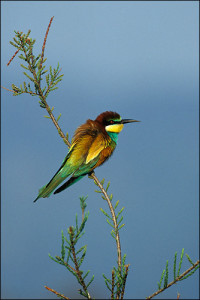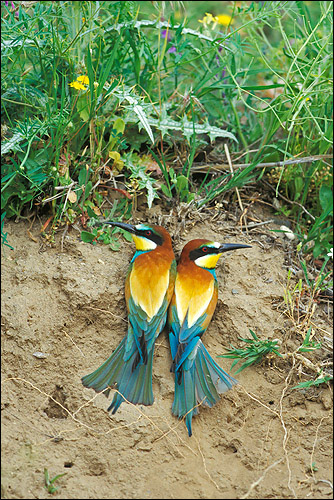European Bee-eater (Merops apiaster)
Bees and wasps do, of course, sting, and Bee-eaters have a very thorough way of dealing with this problem so as not to ingest the toxin. They take the insect by its midriff and hammer its head on to the perch beside them, disabling it. They then transfer their grip to its rear end, lean over to their other side and rub it on the perch up to ten times, a process which causes the venom to be discharged as the abdomen is crushed. Finally, they revert to the first side and, once again, subject the insect to a beating on its head. Stingless insects are spared the abdomen crushing, but they are beaten about the head vigorously, and the larger ones may be battered up to 80 times. Each individual Bee-eater will invariably beat a bee on one side and rub it on the other, a bit like being right or left-handed.
Most Bee-eaters live in colonies, and studies on their vocalisations have shown that each individual in the colony recognises everyone else by their unique calls. This helps social cohesion and makes pair formation easier (the birds have few ostentatious displays). In addition it also allows non-breeding first year birds to recognise their parents and help in the breeding attempt. These supernumeraries are usually males, and they may help their father and mother with feeding the young, and possibly in other nest duties as well.
Bee-eaters lay a lot of eggs, one every day for about a week, but they begin incubation with the first. Since each egg needs the same amount of time to develop, this means that the ages of the nestlings are invariably staggered when they hatch. There is no democracy in a Bee-eater nest, and every chick must compete to be fed, something that the younger chicks do less vigorously than the oldest. So the older birds get the lion’s share of the food deliveries, and only when food is abundantly available do the younger birds have a chance of survival.
Habitat Open areas with plenty of insects and high perches. Particularly fond of river valleys.
Food Flying insects, especially bees and wasps. Often obtained by aerial sally from perch.
Movements A summer migrant wintering in West or Southern Africa. Departs between August and October and arrives back in March and April.
Voice A liquid, rolling “prrt” is the main call. The calls are individually recognisable.
Pairing style Monogamous.
Nesting Usually colonial, but sometimes as single pairs.
Nest A chamber at the end of a tunnel 1-3 m long, excavated by both birds. No material.
Productivity 1 brood a year.
Eggs 4-7, sometimes up to 10.
Incubation 20 days, by both parents.
Parenting style Young fed and tended by both parents and often by an extra helper or two.
Young Nest-bound, altricial and naked.
Food to young Flying insects, similar to adults’ diet.
Leaving nest The young fledge at 25-30 days, and will then be fed outside for a few days. The family often departs together on migration.


